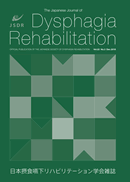Volume 3, Issue 2
The Japanese Journal of Dysphagia Rehabilitation
Displaying 1-8 of 8 articles from this issue
- |<
- <
- 1
- >
- >|
Review Article
-
1999 Volume 3 Issue 2 Pages 3-9
Published: December 30, 1999
Released on J-STAGE: June 06, 2019
Download PDF (3372K)
Original Paper
-
1999 Volume 3 Issue 2 Pages 10-15
Published: December 30, 1999
Released on J-STAGE: June 06, 2019
Download PDF (2427K) -
1999 Volume 3 Issue 2 Pages 16-20
Published: December 30, 1999
Released on J-STAGE: June 06, 2019
Download PDF (1811K)
Clinical Report
-
1999 Volume 3 Issue 2 Pages 21-27
Published: December 30, 1999
Released on J-STAGE: June 06, 2019
Download PDF (3365K) -
1999 Volume 3 Issue 2 Pages 28-35
Published: December 30, 1999
Released on J-STAGE: June 06, 2019
Download PDF (3204K)
Research Report
-
1999 Volume 3 Issue 2 Pages 36-46
Published: December 30, 1999
Released on J-STAGE: June 06, 2019
Download PDF (4517K)
Clinical Hint
-
1999 Volume 3 Issue 2 Pages 47-49
Published: December 30, 1999
Released on J-STAGE: June 06, 2019
Download PDF (1907K) -
1999 Volume 3 Issue 2 Pages 50-51
Published: December 30, 1999
Released on J-STAGE: June 06, 2019
Download PDF (917K)
- |<
- <
- 1
- >
- >|
